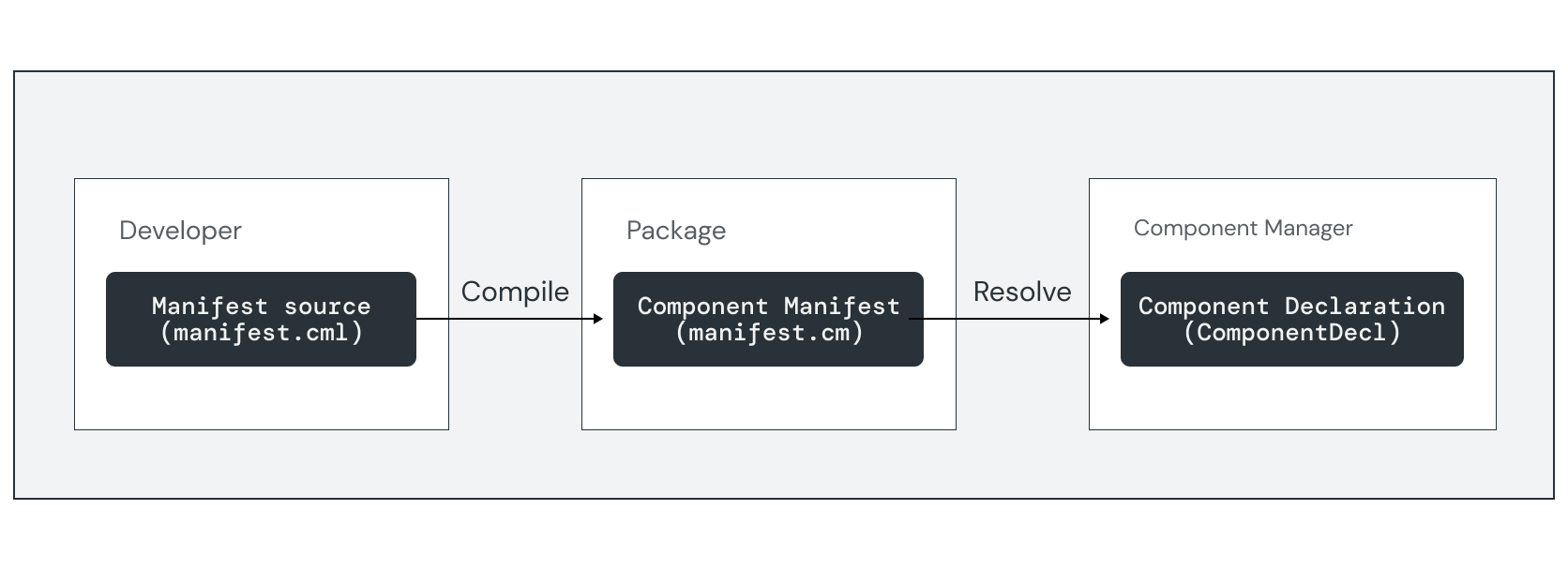每个组件都有一个声明,用于描述组件的属性和功能。对于在软件包中分发的组件,声明 使用组件清单文件表示,并借助 组件解析器。

您可以使用组件清单语言 (CML) 文件来声明组件。在构建时,组件清单编译器 (cmc) 工具会验证并将清单源代码编译为二进制格式 (.cm),并将其存储在组件的软件包中。在运行时,组件解析器会将二进制清单加载到 ComponentDecl FIDL 结构中,以便 Component Manager 使用。
组件清单
CML 文件是 JSON5 文件,此类文件以
.cml扩展程序。下面是一个简单组件的 CML 清单文件示例
运行输出“Hello, World”的 ELF 二进制文件写入系统日志:
{
// Information about the program to run.
program: {
// Use the built-in ELF runner.
runner: "elf",
// The binary to run for this component.
binary: "bin/hello",
// Program arguments
args: [
"Hello",
"World!",
],
},
// Capabilities used by this component.
use: [
{ protocol: "fuchsia.logger.LogSink" },
],
}
此文件声明了与组件相关的两个主要信息部分:
program:描述可执行文件信息,例如二进制文件、程序参数和关联的运行时。在此示例中,二进制文件会编译为 ELF 可执行文件,并使用内置的 ELF 运行程序。use:声明此组件运行所需的功能。在此示例中,fuchsia.logger.LogSink协议使组件能够将消息写入系统日志 (syslog)。
清单分片
某些功能集代表了系统中许多组件(例如日志记录)共有的用例要求。为了简化包含这些 功能,框架会将它们抽象为 清单分片(可包含在 CML 源文件中)。
以下是与上一示例等效的 CML。在这种情况下,
包括通过添加
diagnostics/syslog/client.shard.cml,而不是声明
fuchsia.logger.LogSink:
{
include: [ "syslog/client.shard.cml" ],
// Information about the program to run.
program: {
// Use the built-in ELF runner.
runner: "elf",
// The binary to run for this component.
binary: "bin/hello-world",
// Program arguments
args: [
"Hello",
"World!",
],
},
}
构建组件
Fuchsia SDK 系统提供了构建和打包软件的 Bazel 规则 集成到 Fuchsia 组件中。Fuchsia SDK 环境会在 Bazel 工作区目录中提供这些规则。
在 Bazel 工作区中,您可以将 Fuchsia 软件包和组件声明为 Bazel 软件包中的 Bazel 目标,该软件包由 BUILD.bazel 文件描述。
以下是简单 C++ 组件的 BUILD.bazel 文件示例:
# Build rules provided by the Fuchsia SDK
load(
"fuchsia_cc_binary",
"fuchsia_component",
"fuchsia_component_manifest",
"fuchsia_package",
)
fuchsia_cc_binary(
name = "hello_world",
srcs = [
"hello_world.cc",
],
)
fuchsia_component_manifest(
name = "manifest",
src = "meta/hello_world.cml",
)
fuchsia_component(
name = "component",
manifest = ":manifest",
deps = [":hello_world"],
)
fuchsia_package(
name = "pkg",
package_name = "hello_world",
visibility = ["//visibility:public"],
deps = [
":component",
],
)
此文件包含以下主要元素:
fuchsia_cc_binary():将 C++ 源代码编译为二进制文件,包括所有必要的库依赖项。fuchsia_component_manifest():使用cmc将组件清单源文件 (.cml) 编译为二进制组件声明。fuchsia_component():将二进制文件、组件清单和其他资源收集到单个目标中。fuchsia_package():组件的分布单位。允许将一个或多个组件托管在软件包仓库中,并包含在目标设备的软件包集中。此目标会生成软件包元数据和 build Fuchsia 归档 (.far) 文件。
练习:创建新组件
在本练习中,您将构建并运行一个基本组件,用于读取程序 参数,并在系统日志中回显问候语。
首先,在 Bazel 工作区中为名为 echo 的新组件创建一个新项目目录:
mkdir -p fuchsia-codelab/echo
完成本部分后,项目应具有以下目录结构:
//fuchsia-codelab/echo
|- BUILD.bazel
|- meta
| |- echo.cml
|
|- echo_component.cc
|- echo_component.h
|- main.cc
BUILD.bazel:可执行二进制文件、组件和软件包的 Bazel 构建目标。meta/echo.cml:用于声明组件可执行文件的清单; 所需的功能。echo_component.cc:C++ 组件功能的源代码。main.cc:C++ 可执行二进制文件主入口点的源代码。
添加程序参数
组件清单文件定义了组件可执行文件的属性, 包括程序参数和组件功能。
创建 echo/meta/echo.cml 并添加以下内容:
echo/meta/echo.cml:
{
include: [
"syslog/client.shard.cml",
],
// Information about the program to run.
program: {
// Use the built-in ELF runner.
runner: "elf",
// The binary to run for this component.
binary: "bin/echo_example",
// Program arguments
args: [
"Alice",
"Bob",
],
// Program environment variables
environ: [ "FAVORITE_ANIMAL=Spot" ],
},
// ...
}
记录参数
为主可执行文件创建 echo/main.cc 源文件,并将
以下 import 语句:
echo/main.cc:
#include <lib/syslog/global.h>
#include <cstdlib>
#include <iostream>
#include <string>
#include "echo_component.h"
为 main() 函数添加以下代码:
echo/main.cc:
int main(int argc, const char *argv[], char *envp[]) {
// Read program arguments, and exclude the binary name in argv[0]
std::vector<std::string> arguments;
arguments.resize(0);
for (int i = 1; i < argc; i++) {
arguments.push_back(argv[i]);
}
// Include environment variables
const char *favorite_animal = std::getenv("FAVORITE_ANIMAL");
if (favorite_animal != NULL) {
arguments.push_back(favorite_animal);
}
// Print a greeting to syslog
FX_LOGF(INFO, "echo", "Hello, %s!", echo::greeting(arguments).c_str());
return 0;
}
这段代码读取程序参数,并将其传递给名为
greeting(),用于为 syslog 条目生成响应。
创建 echo/echo_component.h 和 echo/echo_component.cc,包括
以下代码来实现 greeting() 函数:
echo/echo_component.h:
#include <string>
#include <vector>
namespace echo {
std::string greeting(std::vector<std::string> &names);
} // namespace echo
echo/echo_component.cc:
#include "echo_component.h"
#include <numeric>
namespace echo {
static std::string join(std::vector<std::string> &input_list,
const std::string &separator) {
return std::accumulate(
std::begin(input_list), std::end(input_list), std::string(""),
[&separator](std::string current, std::string &next) {
return current.empty() ? next : (std::move(current) + separator + next);
});
}
// Return a proper greeting for the list
std::string greeting(std::vector<std::string> &names) {
// Join the list of names based on length
auto number_of_names = names.size();
switch (number_of_names) {
case 0:
return "Nobody!";
case 1:
return join(names, "");
case 2:
return join(names, " and ");
default:
return join(names, ", ");
}
}
} // namespace echo
此函数根据提供的参数列表创建简单的字符串, 列表长度上限。
添加到构建配置
创建 echo/BUILD.bazel 文件并在其中添加以下构建规则
构建配置中的新组件:
echo/BUILD.bazel:
load(
"@fuchsia_sdk//fuchsia:defs.bzl",
"fuchsia_cc_binary",
"fuchsia_component",
"fuchsia_component_manifest",
"fuchsia_package",
"fuchsia_select",
"fuchsia_unittest_package",
)
fuchsia_cc_binary(
name = "echo_example",
srcs = [
"echo_component.cc",
"echo_component.h",
"main.cc",
],
deps = [] + fuchsia_select({
"@platforms//os:fuchsia": [
"@fuchsia_sdk//pkg/fdio",
"@fuchsia_sdk//pkg/syslog",
],
}),
)
fuchsia_component_manifest(
name = "manifest",
src = "meta/echo.cml",
component_name = "echo",
includes = [
"@fuchsia_sdk//pkg/syslog:client",
],
)
fuchsia_component(
name = "component",
component_name = "echo",
manifest = ":manifest",
visibility = ["//visibility:public"],
deps = [":echo_example"],
)
fuchsia_package(
name = "pkg",
package_name = "echo-example",
visibility = ["//visibility:public"],
components = [
":component",
],
)
运行 bazel build 并验证构建是否成功完成:
bazel build //fuchsia-codelab/echo:pkg
在下一部分中,您将将此组件集成到 build 中,并测试系统日志中的输出。

